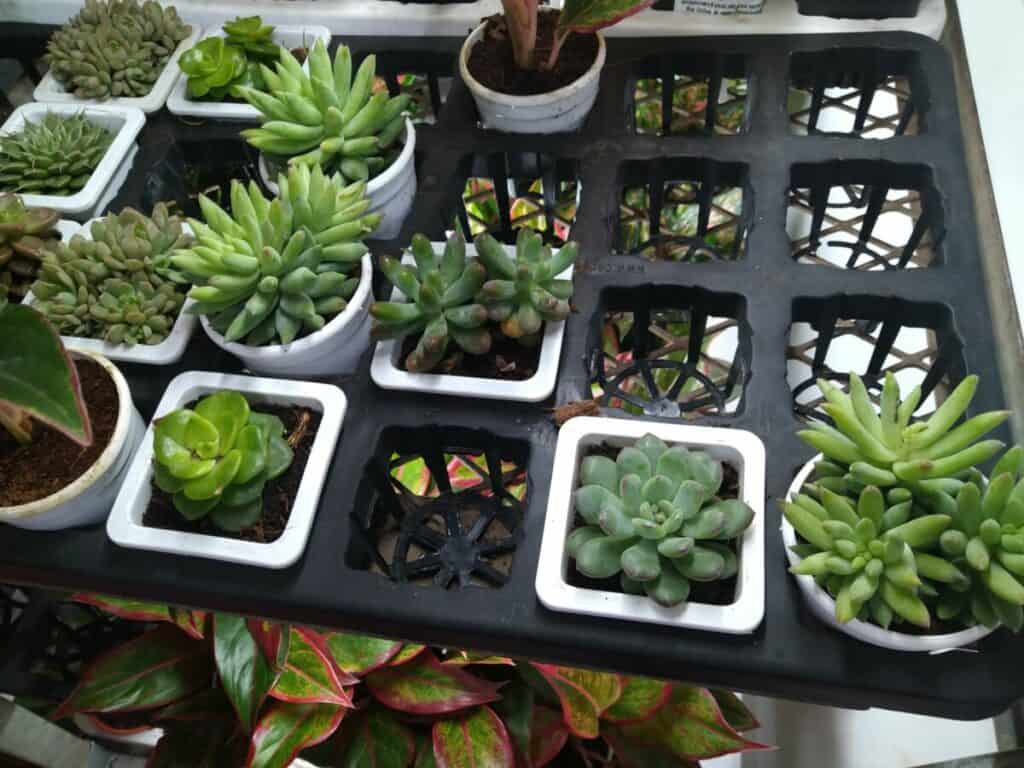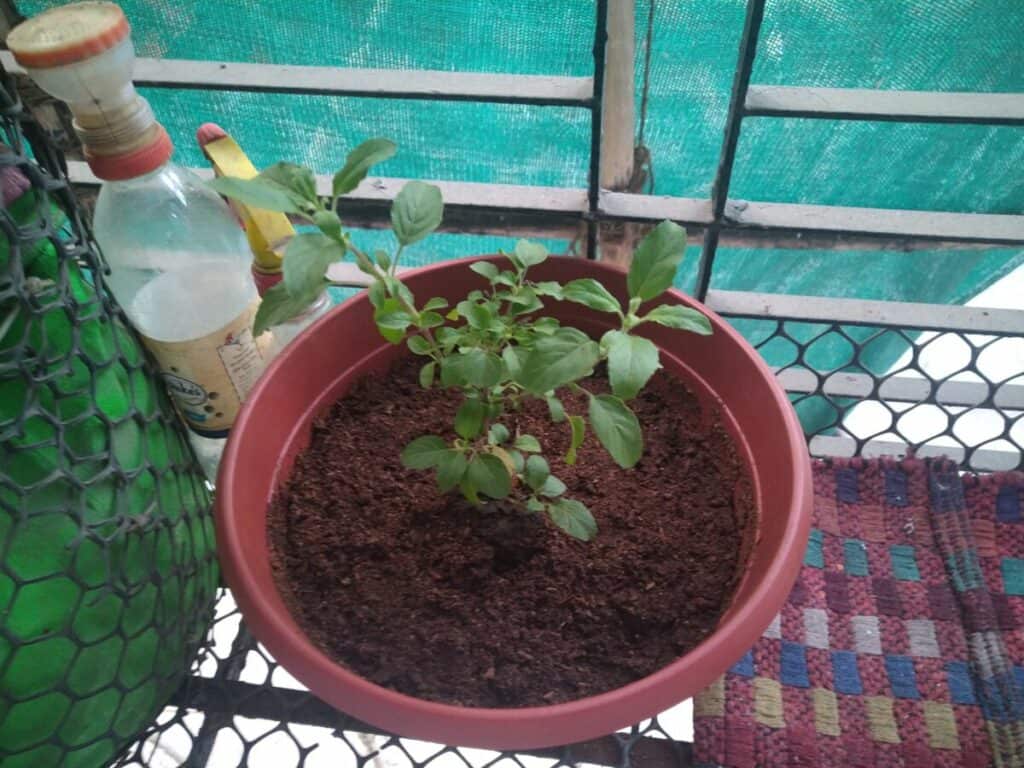I wanted to know how often to water the plants in my balcony and wrote this guide so it can help others searching for an answer.
You should water your balcony plant when the first inch of soil is dry. But this is a general idea and there are many factors like soil, container, weather, plant type, and the growth stage that determine how often to water.
I’ve written a lot of details below that will help you figure out the best frequency to water the plants in your balcony. This will help keep your plants in good condition without risk of under-watering or over-watering.
When you should water your balcony plants?
There are some factors that can help you understand better how often you’ll need to water your plants.
Type of plant
The type of plant determines how frequent or infrequent you need to water. Succulents and drought-tolerant plants need less watering. They can go without water for 10-15 days.

But plants that are annuals and vegetables may need to be watered every day. Vegetables like tomatoes and cucumbers need a lot of water. You may need to water summer vegetables every day or 2-3 times per day in the summer.
Herbs like cilantro, oregano, and basil need to dry out a bit before watering. They tend to grow better and tastier with this method. Other herbs like chives and parsley need more watering.
Flowering plants that are annuals also need daily watering to keep their roots moist.

Growth stage
The frequency and amount of water your plant needs depends on where it’s at in its growth stage.
A seedling or transplant will need a lot more frequent watering than a plant that has matured in the pot. A young plant needs to spread its roots before it can be tolerant of a period without water.
So you can water a seedling or transplant every day or as much as required.
To encourage the young plant, you need to water deeply and slowly so the water penetrates deep into the container. This helps the plants to reach out for the water and strengthen their root system.
A smaller plant has a smaller root system which means it needs more frequent watering.
Soil
The type of soil you use in the container determines how often you need to water the plant. The soil has to retain moisture and be well-draining.
You can put your finger an inch or two in the soil. If there’s no moisture, that’s a sign you need to water the soil.
That’s why it’s not good to use garden soil in pots as they may not have this characteristic. They could have lots of clay or sand and prevent moisture retention.
I would suggest using a good potting soil based on the needs of the plant.
If you’re growing succulents you need potting soil that does not retain as much moisture. But if you’re growing vegetables, you’ll need potting soil that does.
You can get potting soil that comes with moisture-absorbing materials. This helps you reduce the frequency of watering as the soil retains moisture for a longer period of time.
If the soil has dried out, it does not absorb moisture at the rate it used to. The best way to solve this is to submerge the pot in a bigger vessel full of water for an hour.
This will help the soil to get back it’s moisture-retaining properties while draining out well.
If the pot is too large to move around, another solution is to keep watering the soil a couple of times. This repeated watering will help loosen the dry soil and help it recover back it’s moisture-retaining properties.
Container
The type of container you use plays a major factor in how much moisture the soil will retain.
I recommend using as large a container as you can. This helps the container to retain more water in the soil. And the plants can spread their roots deeper and become more tolerant to less watering.
You can get by watering a large container once every 2-3 days for plants that need a lot of water.
If you have small containers, then you need to water the plants quite frequently.
Water the plants in small containers at least once per day and more often in the summers.
You also need to consider the material used for the containers. Those made from a porous material like terracotta dry out faster.
And containers made from materials like metal or plastic can heat up from intense sunlight and dry out. You can place such pots inside a larger ceramic or terracotta pot for protection.
You also get self-watering containers that consist of a container and a reservoir. You put the plant in the container and fill the reservoir with water. The plant’s roots keep wicking the water from the reservoir as needed.
Weather
Weather plays a major part in how often you need to water the plants in your balcony. In cold weather like in autumn or winter, you don’t need to water as often.
The plants on a balcony face lots of environmental factors like the weather, wind, and intense sunlight. That’s why they may need even more care than growing plants in other areas of the house.
You can use a screen to protect the balcony plants from drying out due to intense sunlight and the wind.
In cool weather, plants that need a lot of water can get by with watering every 3-4 days without any problems.
In warm weather, plants with high water requirements, need to be watered 2-3 times per day depending on their condition.
How should you water the plants in your balcony?
Here are some tips that will help you water the plants in the best possible way.
- Water the plants slowly and thoroughly. This helps the water to reach through the entire soil and the bottom of the pots. Which helps the plants to develop stronger and deeper roots.
- Water the plants in the morning before sunrise. This helps the soil absorb enough moisture before the heat evaporates it. You can water in the evening too but if the water stays on the plants, it can lead to fungal disease.
- Make sure to not splash water on the foliage of the plants. The moisture can lead to disease. And in hot conditions, it can cause leaf burn.
- Make sure to stick your finger in the soil a couple of inches. This helps you find out whether the soil is moist or does need watering.
- You can invest in a drip irrigation system to get the best possible watering. This helps provide water to the roots in a slow and controlled manner. You can adjust the settings during the summer and other seasons.
- You can use self-watering containers that help you reduce how often you need to water the plants. You fill the reservoir with water and the plants take in as much water as they need.
- You can use a moisture sensor to find out the condition of the soil. This gives a more accurate way to understand when you need to water the plants.
- Use mulch like wood chips, grass clippings, or dried leaves to cover the soil in the pots. This helps the soil retain moisture by reducing evaporation.
- Protect your balcony plants from the sun and wind to reduce problems of drying out. You can place them in another location or make use of a screen for protection.

Fact Checked, Written, and Published by Kevin Rodrigues
Kevin is the founder of Gardening Mentor, a website that aims to teach people to grow their own food in a limited space. As a self-taught gardener, Kevin has spent several years growing plants and creating gardening content on the website. He is certified in Home Horticulture and Organic Gardening from Oregon State University. He has a Post Graduate Diploma in Horticulture and Landscape Gardening from Mumbai University.
Read more
